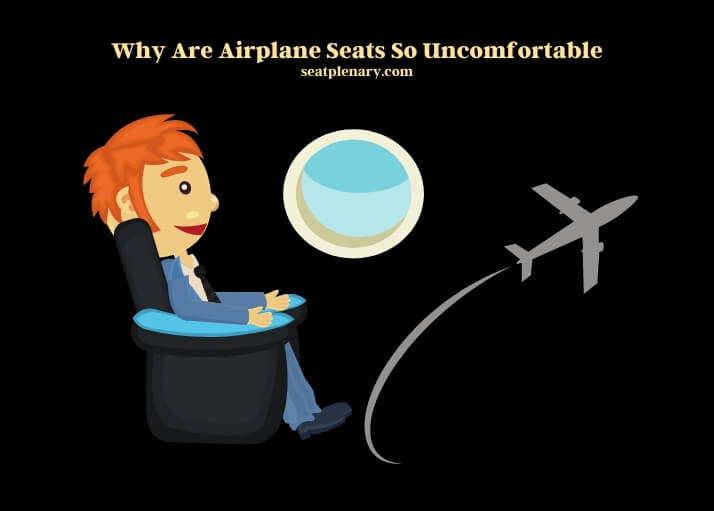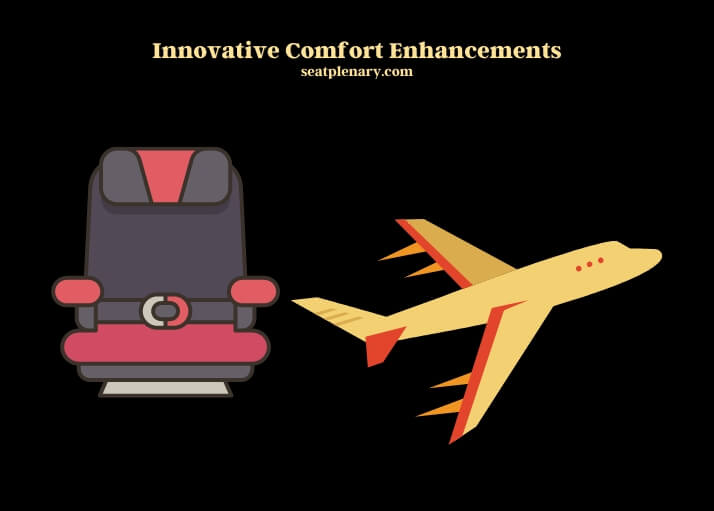Airplane seats are often uncomfortable due to their design and the need to maximize cabin space. This results in limited legroom, narrow seats, and minimal recline, contributing to passenger discomfort during flights.
The discomfort experienced in airplane seats stems from several factors beyond just the physical dimensions of the seating area. Airlines face the challenge of balancing passenger comfort with economic efficiency, leading to designs that prioritize fitting more seats over providing ample space for each passenger. This approach affects not only the legroom but also the width of the seats, forcing passengers into closer proximity than might be comfortable for long durations.
The materials used in seat construction are chosen for durability and ease of maintenance rather than comfort, which can make the seats feel hard and unforgiving over time.

Ergonomics also plays a crucial role in the discomfort felt by passengers. Seats are not always designed with the diverse body shapes and sizes of the global population in mind, leading to a one-size-fits-all approach that doesn’t suit everyone. The lack of proper lumbar support and the ability to adjust seating positions can exacerbate discomfort on longer flights.
The psychological impact of anticipating an uncomfortable flight can heighten the sense of discomfort, making the overall experience more unpleasant. Airlines are exploring ways to address these issues, but the fundamental constraints of space and cost often limit the extent of improvements that can be made.
Design Constraints and Economic Pressures
Airplane seats are often the subject of passengers’ discomfort during flights. The primary factors contributing to this discomfort include design limitations, space constraints, and economic considerations by airlines. Airlines are tasked with maximizing the number of passengers they can accommodate on each flight.
This objective often leads to reduced seat pitch and width, directly impacting passenger comfort. The table below illustrates the variations in seat pitch and width across different airlines and classes, highlighting the tight spaces passengers must contend with.
| Airline | Class | Seat Pitch (inches) | Seat Width (inches) |
| JetBlue | Economy | 30 | 17 |
| Southwest Airlines | Economy | 31 | 18 |
| United Airlines | Business | 60 | 21 |
| Delta Air Lines | First Class | 78 | 22 |
Shifting Shapes: The Evolution of Airline Seating
Over the years, airline seats have undergone significant transformations in size, shape, and functionality. These changes have been driven by technological advancements, shifting passenger expectations, and the airlines’ ongoing quest to balance comfort with profitability. Initially, seats were designed with generous space and comfort in mind, catering to the less crowded skies of early aviation.
As air travel became more accessible and demand increased, the focus shifted towards accommodating more passengers. This timeline showcases key milestones in the evolution of airline seating, reflecting the trade-offs between comfort and capacity.
Physiology and Comfort: An Ergonomic Challenge
Passenger comfort is not solely a matter of space. Individual physiology, including body type and health conditions, plays a crucial role in how comfortable a seat feels. Ergonomic design challenges arise from the need to accommodate a diverse range of passengers within a confined space. This section delves into the ergonomic considerations that must be balanced in seat design and the importance of inclusive practices to cater to all passengers’ needs.
Material Matters in Seat Comfort
The choice of materials for seat construction significantly affects comfort. From the cushioning to the upholstery, each component either contributes to or detracts from the overall experience. Airlines select materials based on durability, maintenance, cost, and comfort. The comparison below highlights the differences in material choices among airlines, shedding light on how these decisions impact passenger comfort.
| Material Type | JetBlue | Southwest Airlines | United Airlines |
| Cushioning | Foam | Gel | Memory Foam |
| Upholstery | Polyester | Leather | Fabric |
Innovative Comfort Enhancements
Despite the inherent design challenges, airlines have not remained static in their approach to improving seat comfort. Without undertaking complete redesigns, several airlines have introduced adjustable headrests, increased legroom options, and amenity kits to enhance the passenger experience.
These measures, while not solving the fundamental issues of space and design, offer temporary relief and a slightly more comfortable journey.

FAQs
Limited Recline and Personal Space
Airplane seats are often criticized for their limited recline and cramped personal space, contributing significantly to passenger discomfort. The design of airplane seats is primarily focused on maximizing the number of passengers that can be accommodated within the cabin. This approach leads to seats that offer minimal recline, limiting the ability of passengers to adjust their seating position and find a comfortable posture during long flights.
The restricted personal space not only makes it difficult to relax but also increases the likelihood of physical discomfort as passengers are unable to stretch or move freely. The close proximity to other passengers can further exacerbate the feeling of discomfort, making the overall flying experience less pleasant.
Seat Ergonomics and Body Support
The ergonomics of airplane seats often fail to provide adequate support for the body, leading to discomfort during flights. Many seats are designed with a one-size-fits-all approach, neglecting the diverse body shapes and sizes of passengers. This lack of consideration for ergonomic principles means that seats do not always offer the necessary support for critical areas such as the lower back, neck, and legs.
Without proper support, passengers may experience stiffness, soreness, and even pain, particularly on longer flights. The situation is further aggravated by the limited ability to adjust the seat for better support, leaving passengers to endure the discomfort until they reach their destination.
Influence of Passenger Behavior
Passenger behavior can also play a significant role in the discomfort experienced with airplane seats. The actions and habits of fellow travelers, such as reclining their seats abruptly or encroaching on another’s space, can significantly impact one’s comfort.
The use of overhead bins for excessive carry-on luggage can lead to cramped conditions, further reducing the already limited space available. The cumulative effect of these behaviors can make the seating environment feel even more restrictive and uncomfortable, highlighting the importance of considerate travel etiquette to mitigate discomfort for everyone on board.
Impact of Flight Duration
The duration of the flight is a critical factor in the level of discomfort experienced with airplane seats. On short-haul flights, the limitations of seat design and spacing may be tolerable for passengers.
On long-haul flights, the prolonged exposure to these conditions can significantly amplify discomfort. The inability to move freely, combined with the lack of adequate support and personal space, can lead to increased restlessness, fatigue, and even pain. This issue underscores the need for airlines to consider flight duration when designing cabin layouts and selecting seating options to improve passenger comfort on longer journeys.
Temperature Control and Seat Comfort
The cabin temperature can have a surprising effect on the comfort level of airplane seats. Seats that become too warm can lead to discomfort and a feeling of restlessness among passengers. The material of the seat upholstery, along with limited airflow in the cabin, can cause seats to retain heat, making it difficult for passengers to maintain a comfortable body temperature.
Conversely, when the cabin is too cold, the hard surfaces of the seat can become even more uncomfortable. Effective temperature control and the use of breathable materials in seat design could help mitigate these issues, enhancing overall comfort for passengers.
The Psychological Aspect of Seating Discomfort
The psychological impact of seating discomfort on passengers should not be underestimated. The anticipation of flying in an uncomfortable seat can increase stress and anxiety levels even before boarding. This psychological discomfort can exacerbate the physical discomfort experienced during the flight. The feeling of being confined to a small space for an extended period can also contribute to a sense of unease and restlessness.
The psychological aspects of seating discomfort requires a holistic approach, including improving the physical comfort of seats, enhancing the overall cabin environment, and providing passengers with strategies to cope with the stress of flying.
Summary
The discomfort of airplane seats is a multifaceted issue, rooted in design constraints, economic pressures, and the physical realities of flying. While the evolution of seating has seen both improvements and setbacks, understanding the factors at play helps in appreciating the complexities airlines face. Through material innovation and strategic enhancements, there’s ongoing effort to mitigate discomfort, aiming for a balance between efficiency and passenger comfort.
